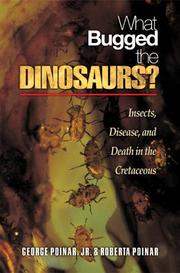| Listing 1 - 3 of 3 |
Sort by
|

ISBN: 1282531662 9786612531668 1400835690 9781400835690 9780691124315 0691124310 9781282531666 6612531665 Year: 2010 Publisher: Princeton, NJ
Abstract | Keywords | Export | Availability | Bookmark
 Loading...
Loading...Choose an application
- Reference Manager
- EndNote
- RefWorks (Direct export to RefWorks)
This book reveals that T. rex was not the only killer in the Cretaceous: insects--from biting sand flies to disease-causing parasites--dominated life on the planet and played a significant role in the life and death of the dinosaurs. Analyzing exotic insects fossilized in Cretaceous amber at three major deposits in Lebanon, Burma, and Canada, the authors reconstruct the complex ecology of a hostile prehistoric world inhabited by voracious swarms of insects. They draw upon tantalizing new evidence from their discoveries of disease-producing vertebrate pathogens in Cretaceous blood-sucking flies, as well as intestinal worms and protozoa found in fossilized dinosaur excrement, to provide a unique view of how insects infected with malaria, leishmania, and other pathogens, together with intestinal parasites, could have devastated dinosaur populations.--From publisher description.
Amber fossils. --- Plants, Fossil --- Dinosaurs --- Insects, Fossil --- Insects, Fossil. --- Paleoecology --- Paleontology --- Amber --- Biological inclusions in amber --- Fossil-bearing amber --- Fossiliferous amber --- Fossils in amber --- Fossils --- Fossil plants --- Plant fossils --- Dinosauria --- Reptiles, Fossil --- Arthropoda, Fossil --- Paleoentomology --- Cretaceous Period --- Diseases. --- Parasites. --- Ecology. --- Biological inclusions --- Inclusions
Book
ISBN: 9004210717 9789004210714 9789004210707 9004210709 Year: 2013 Publisher: Leiden Boston
Abstract | Keywords | Export | Availability | Bookmark
 Loading...
Loading...Choose an application
- Reference Manager
- EndNote
- RefWorks (Direct export to RefWorks)
Insects are the most diverse group of life on Earth and their history extends well into the Paleozoic, making them among the oldest of terrestrial animal lineages. They are critical to the well being of ecosystems from the equator to the poles, and are inexorably tied to the well being of our world. Whether beneficial or malignant, insects wield an overwhelming influence on our health, economy, and security. It is little wonder that insects so consistently appear in our cultures, religions, and mythologies. Given such realities, it is vital that we gain a better understanding and appreciation of Nature’s ‘inordinate fondness’. Indeed, there is considerable wisdom to be found in the study of these marvels of evolution, and what better way to understand their present and future than to peer back into their distant past. Here presented are some of the results of the 6th International Congress on Fossil Insects, Arthropods and Amber (FossilX3) held in Byblos, Lebanon in April, 2013. In the tradition of previous congresses, researchers from around the world gathered to discuss the latest developments and to build new co-operative endeavours. Recognizing that the future of our science is one of interdisciplinary collaboration, these meetings steadily grow in importance, and proceedings such as this reveal the latest hypotheses and conclusions, while inspiring others toward newer and greater goals.
Insects, Fossil --- Amber fossils --- Geology, Stratigraphic --- Insects --- Hexapoda --- Insecta --- Pterygota --- Arthropoda --- Entomology --- Age of rocks --- Rocks --- Stratigraphic geology --- Physical geology --- Amber --- Biological inclusions in amber --- Fossil-bearing amber --- Fossiliferous amber --- Fossils in amber --- Fossils --- Arthropoda, Fossil --- Paleoentomology --- Evolution --- Age --- Biological inclusions --- Inclusions --- Insectes fossiles --- Fossiles dans l'ambre --- Arthropodes fossiles --- Paléoentomologie --- Insectes --- Stratigraphie --- Congresses. --- Congrès
Book
ISBN: 9783031090448 Year: 2022 Publisher: Cham Springer International Publishing :Imprint: Springer
Abstract | Keywords | Export | Availability | Bookmark
 Loading...
Loading...Choose an application
- Reference Manager
- EndNote
- RefWorks (Direct export to RefWorks)
While much attention has been given to animal life in amber, the remains of a variety of plants, including angiosperm flowers, also exist in fossilized resin. Presented here is a pictorial synopsis of 94 flowers that occur in four major amber deposits around the world. These deposits are from Burma (Myanmar), the Baltic area, the Dominican Republic and Mexico, and range in age from the mid-Cretaceous to the mid-Tertiary. The basic features of these flowers are presented and their relationship with existing plant lineages discussed. This work will be of interest to amber enthusiasts, plant taxonomists, plant morphologists, plant ecologists, plant evolutionists and plant paleontologists.
Angiosperms, Fossil. --- Amber fossils. --- Amber --- Biological inclusions in amber --- Fossil-bearing amber --- Fossiliferous amber --- Fossils in amber --- Fossils --- Plants, Fossil --- Biological inclusions --- Inclusions --- Botany. --- Paleontology. --- Plant ecology. --- Plants --- Plant Science. --- Plant Ecology. --- Plant Evolution. --- Evolution. --- Plant evolution --- Evolution (Biology) --- Botany --- Floristic ecology --- Phytoecology --- Vegetation ecology --- Ecology --- Fossilogy --- Fossilology --- Palaeontology --- Paleontology, Zoological --- Paleozoology --- Historical geology --- Zoology --- Prehistoric animals in motion pictures --- Botanical science --- Floristic botany --- Phytobiology --- Phytography --- Phytology --- Plant biology --- Plant science --- Biology --- Natural history --- Phylogeny
| Listing 1 - 3 of 3 |
Sort by
|

 Search
Search Feedback
Feedback About UniCat
About UniCat  Help
Help News
News